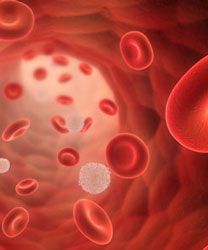Tisagenlecleucel Demonstrates Durable Response Beyond 1 Year in DLBCL
At a median follow-up of 14.1 months, the chimeric antigen receptor T-cell therapy tisagenlecleucel achieved an objective response rate of 52% in adult patients with relapsed/refractory diffuse large B-cell lymphoma.

At a median follow-up of 14.1 months, the chimeric antigen receptor (CAR) T-cell therapy tisagenlecleucel (Kymriah) achieved an objective response rate (ORR) of 52% in adult patients with relapsed/refractory diffuse large B-cell lymphoma (DLBCL), according to updated data from the phase II JULIET study presented at the 2018 European Hematology Association (EHA) Congress.
The 52% (95% CI, 41-62) ORR included a complete response (CR) rate of 40% and a partial response (PR) rate of 12%. This response was durable, as the duration of response had not been reached at data cutoff.
These response rates were consistent across all subgroups, including patients receiving prior allogeneic stem cell transplantation (ASCT), and in patients having double-hit lymphoma. Additionally, the 12-month relapse-free survival (RFS) rate in patients with a CR was 78.5% (95% CI, 60%-89%) and the 12-month RFS rate in all responders was 65% (95% CI, 49%-78%).
No patients proceeded to transplant while in response.
Peter Borchmann MD, of the Department of Internal Medicine, University Hospital of Cologne in Cologne, Germany, discussed long-term results from the JULIET trial that were updated after an additional 8 months of follow-up since the last presentation of JULIET results at the 2017 ASH conference in December. JULIET is single-arm open-label global phase II trial (NCT02445248) of tisagenlecleucel in adult patients with relapse/refractory DLBCL, who were ineligible for or had failed autologous stem cell transplant (ASCT).
“The current standard of care for DLBCL patients is high dose chemotherapy followed by auto-SCT; however, only a minority of patients actually receive transplant; approximately 50% are ineligible due to age or infirmity,” said Borchmann.
In August 2017, tisagenlecleucel became the first CAR T-cell therapy approved by the FDA when the agency authorized the treatment’s use for patients up to 25 years of age with B-cell precursor acute lymphoblastic leukemia that is refractory or in second or later relapse. Based on earlier findings from the JULIET study, the FDA approved tisagenlecleucel in May 2018 for use in adult patients with relapsed/refractory large B-cell lymphoma—including DLBCL, high-grade B-cell lymphoma and DLBCL arising from follicular lymphoma—after 2 or more lines of systemic therapy.
Of the 165 adult patients enrolled in JULIET, 111 patients were infused with a single dose of tisagenlecleucel (median, 3.0×108cells [range, 0.1-6.0×108 cells]). 92% of patients received bridging therapy and 93% received lymphodepleting chemotherapy. Median follow-up from infusion to data cutoff was 14 months with a maximum follow-up of 23 months.
Median age of the patients was 56 years (range, 22-76). Borchmann pointed out that nearly a quarter (23%) of patients were older than 65.
Centrally manufactured CAR T cells were provided using cryopreserved apheresis and a global supply chain.
The primary endpoint of JULIET was best ORR (CR + PR) per independent review committee. Efficacy results were reported for 93 patients in the main cohort having at least 3 months’ follow-up or earlier discontinuation and the safety cohort included all 111 infused patients.
The median overall survival (OS) among all infused patients was 11.7 months (95% CI, 6.6-NE), with a 12-month OS rate of 49%. Median OS was not reached for patients in CR (95% CI, 17.9-NE), and the 12-month OS rate was 95% for these patients.
The response status at 3 months indicated durable clinical benefit; the estimated progression-free survival rate at 12 months was 83% for patients with CR or PR at 3 months.
“Adverse events were effectively managed by appropriately trained study-site personnel,” Borchmann noted. “Baseline tumor volume, LDH, ferritin, and CRP levels are associated with higher risk of any-grade cytokine release syndrome or neurotoxicity,” he added.
Grade 3 cytokine release syndrome occurred in 14% of patients, with 8% of patients experiencing grade 4. Grade 3 neurological adverse events occurred in 7% of patients, with 5% experiencing grade 4.
Three patients died ≤30 days of infusion due to disease progression, as reported in the preliminary analysis. No additional deaths have occurred and no deaths were attributed to tisagenlecleucel, CRS, or cerebral edema.
“Tisagenlecleucel produced high response rates in a cohort of highly pretreated adult patients with relapsed or refractory DLBCL. With longer follow-up, these results confirm results from the primary analysis and show a high percentage of prolonged durable responses can be achieved,” concluded Borchmann.
<<< 2018 European Hematology Association Congress
Borchmann P, Tam CS, Jager U, et al. An updated analysis of JULIET, a global pivotal Phase 2 trial of tisagenlecleucel in adult patients with relapsed or refractory (r/r) diffuse large b-cell lymphoma (DLBCL). Presented at: 2018 EHA Congress; June 14-17, 2018; Stockholm, Sweden. Abstract S799.
 
At study entry, 76% of infused patients had stage III/IV disease, 17% had double/triple hit mutations in MYC/BCL2/BCL6. Germinal center B-cell disease was present in 57% of patients, and 41% had activated B-cell molecular subtypes. The patients had received a median of prior 3 lines of antineoplastic therapy (range, 1-6), with 95% undergoing ≥2 prior treatments, including prior ASCT in 49% of patients.



